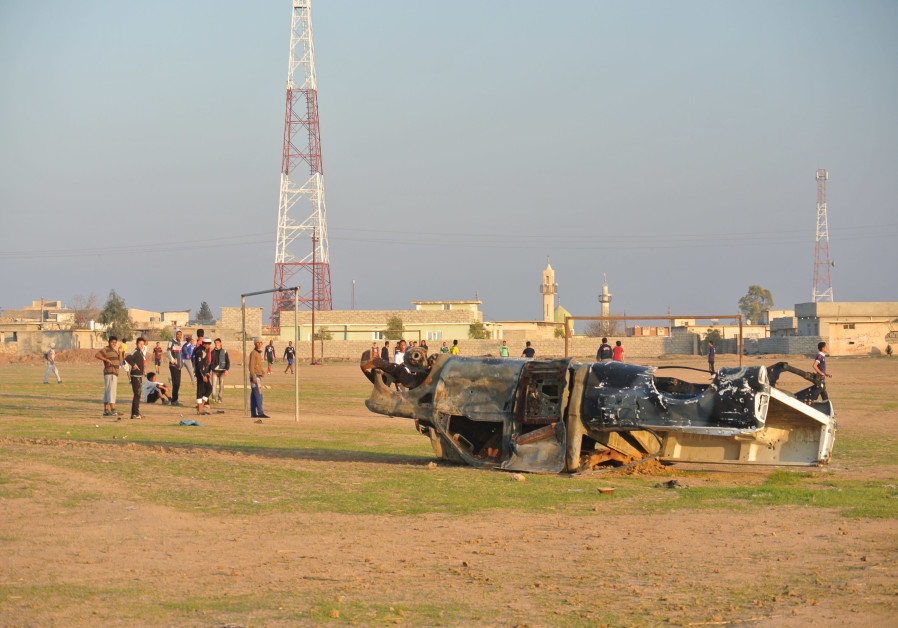Yazidi genocide survivors say ISIS supporters returning to northern Iraq

Youth play next to a destroyed car in a village near Rabia on he road to Sinjar in 2015 . (photo credit: SETH J. FRANTZMAN)
Yazidi activists accused Baghdad of allowing people who “took part in the 2014 genocide” to return to villages near Sinjar in northern Iraq. On Tuesday, video and photos were posted online showing a long line of trucks and cars waiting near a checkpoint to return to a village east of Sinjar Mountain.
“Yazidis concerned over return of families involved in Islamic State Shingal massacre,” tweeted one activist. “The return of these people will become a threat to the lives of people in Shingal, and bad things may happen which we do not accept.”
In August 2014, Islamic State attacked the area around Sinjar mountain where hundreds of thousands of Yazidis, members of a religious minority, live. ISIS captured more than 10,000 people and systematically separated women and men, murdering the men and selling women and children into slavery. The horrific crime has been called genocide by international organizations. More than 3,000 Yazidi women and children are still missing.
Since Sinjar was liberated in 2015, many Yazidis have not returned due to an unstable security situation and changing control of the area from Kurdish Peshmerga to Iraqi federal forces. However, since Iraq’s federal government and Shi’ite militias took control in October 2017, some Arab families who fled the area have returned. The Shi’ite militias are called Popular Mobilization Forces (PMU).
Local Yazidis accuse some of the local Arab tribes of having supported ISIS and think that the government hasn’t screened the returnees. They are also angry that Yazidis have not been given infrastructure in Sinjar and security, even though these other groups displaced by the fighters are able to return.
The recent statements came after Amy Beam, a human rights advocate for Yazidi survivors of the 2014 genocide, posted a video on Facebook Tuesday showing more than 35 cars and trucks waiting at a checkpoint on a road that leads from Tal Afar to Snune in northern Iraq.
“Video of Sunni Arabs returning August 28 to Gholat village on the east end of Shingal mountain,” she wrote on Facebook. “Residents of Gholat are accused by Ezidi [Yazidi] neighbors of participation with ISIS to attack them August 3, 2014.” She says that she is hoping for “peace and justice” and would try to speak with some of the returnees. “Shia and Sunni Arabs also suffered from Daesh and lost their family members and houses. How will the innocent Arabs be separated from the guilty Daesh,” she wrote.
(function(w,d,s,i){w.ldAdInit=w.ldAdInit||[];w.ldAdInit.push({slot:10834723912266086,size:[0, 0],id:”ld-9628-9059″});if(!d.getElementById(i)){var j=d.createElement(s),p=d.getElementsByTagName(s)[0];j.async=true;j.src=”//cdn2.lockerdomecdn.com/_js/ajs.js”;j.id=i;p.parentNode.insertBefore(j,p);}})(window,document,”script”,”ld-ajs”);
YAZIDIS EXPRESSED concern when they heard of the return. One man noted in reaction to the video that he had also passed the same convoy of vehicles. “They were waiting for their names to be checked on the security forces’ computer.”
But others wondered why the US and UN were not doing more to revive life in Sinjar. Dawood Saleh, author of a memoir on the genocide called Walking Alone, said that the government was allowing these residents to return to land “taken from Yazidis in the time of Saddam Hussein’s regime.”
Under Saddam, many Yazidis say their villages were forcibly collectivized, Sunni Arab tribes settling from Sinjar to Mosul as a way for Saddam to cement his control of northern Iraq. “For more than 4 years… Yazidis fled their homes to refugee camps and yet no one helps them to clear their homes from bombs or return them back safely,” Saleh wrote.
ISIS destroyed many Yazidi villages in 2014 and laced them with mines and improvised explosive devices (IEDs) during its occupation of the area. This makes it difficult for Yazidis to return, whereas ISIS did not carry out the same systematic destruction of Arab villages.
The concern in Sinjar is that the government is not checking the returnees sufficiently. Nasir Pasha Khalaf, a member of the Yazidi community, says that many Yazidis who live in Sinjar were prevented from carrying weapons for self-defense after the Iraqi government and Shia militias arrived last year. He says that measures like this and the road closure from Sinjar – and Dohuk, where many Yazidi IDPs live – have prevented his own people from returning.
“We ask the United Nations, the US and the Government of Iraq and people of conscience all over the globe to not allow criminals to return to their places of residence while victims are being tortured under the tents of the displacement.”
In the last seven months, the area of Sinjar has been rocked by many controversies. Visitors say that there are more than 30 checkpoints to get from Mosul or Dohuk to Sinjar, which makes it difficult for people to travel. There is also a network of different militias controlling the checkpoints.
In recent weeks the PMU said it wants to reorganized the control of Sinjar into a new command and withdraw some of its forces. However, Iraq still lacks a new government three months after elections and areas around Mosul and Sinjar have become part of political negotiations between the parties that back the PMU, the Prime Minister’s office and the Kurdish parties. The PMU’s allowing of some Sunni Arabs to return may be in the context of getting a coalition agreement with Sunni political parties.
Only three Yazidis – despite numbering around 500,000 in Iraq – were elected to parliament this year, and their concerns are often ignored or subverted to the political whims of the larger parties.
Beam says many Yazidis now feel a lack of hope and express interest in moving abroad. However, a recent report from Germany says that Yazidis who escaped there are being denied asylum and risk being sent back to Iraq where they can’t return to their homes.
Join Jerusalem Post Premium Plus now for just $5 and upgrade your experience with an ads-free website and exclusive content. Click here>>






Comments are closed.